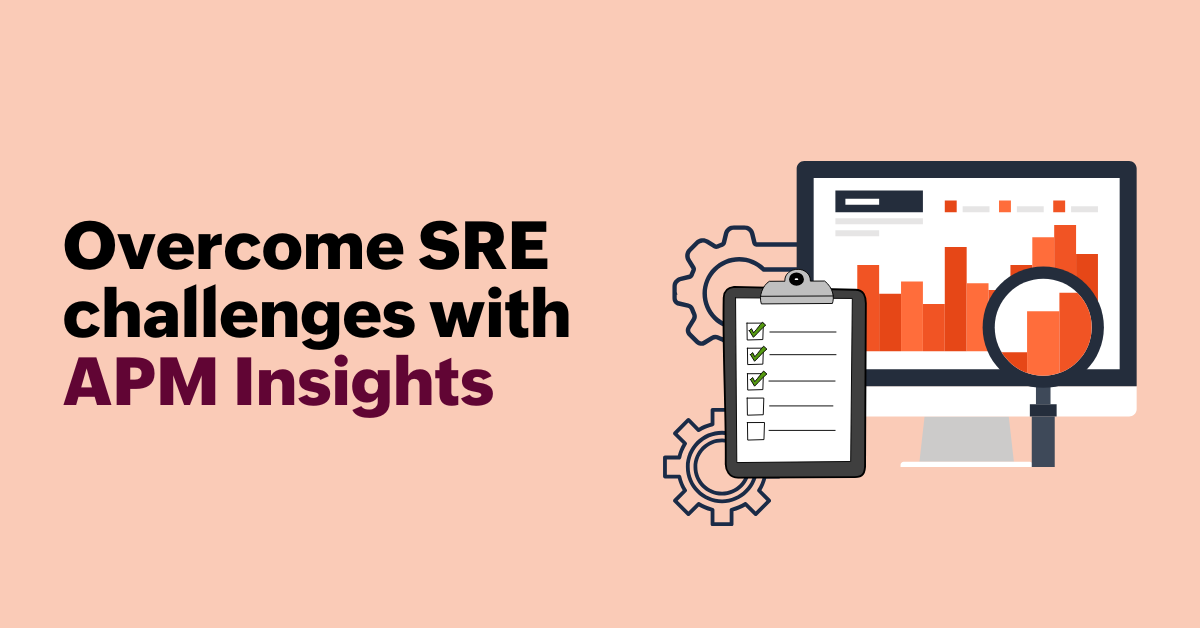Top 10 challenges for SREs and how to overcome them with APM tools

According to Google, "SRE is what you get when you treat operations as a software problem.” The role of site reliability engineers (SREs) is evolving rapidly to ensure optimal application performance in today's evolving IT environments. SREs are expected to provide proactive and predictive solutions for the issues arising from managing such environments. A Gartner report even suggests that by 2025, 70% organizations will be depending on SRE practices to ensure operational resilience. This brings focus on the need for application performance monitoring (APM) tools in maintaining site reliability.
What do SREs do to maintain modern IT operations
SREs are tasked with maintaining uptime, scalability, and optimal performance whilst the complexity of the IT environment keeps scaling up or down depending on requirements. The widespread usage of microservices, Kubernetes, and hybrid infrastructures has propelled the need for full observability and IT automation to speed up processes. By employing APM tools, SREs can gain actionable insights and address performance issues proactively, ensuring seamless operations.
Watch this video to explore SRE challenges and how APM solutions can help overcome them.
Top 10 challenges faced by SREs and solutions with APM
1. Managing distributed systems
Challenge: Identifying performance bottlenecks in complex microservices architectures.
Solution: Unified observability through APM tools can provide end-to-end visibility. Distributed tracing helps SREs pinpoint issues and understand service dependencies effectively.
2. Troubleshooting latency and downtime
Challenge: Identifying the underlying cause of the latency.
Solution: APM tools provide monitoring for key metrics like response time, throughput, and error rates to pinpoint bottlenecks across application layers. Dependency maps can help visualize the associated service components. AI-powered features like transaction tracing and log analysis can drill down to the exact line of code to make fault analysis easy.
3. Balancing automation with manual analysis
Challenge: IT automation should coexist without compromising control.
Solution: Features like anomaly detection, automated alerts, and reporting minimize human intervention, providing relief from the information deluge that comes from the telemetry data. But you are still provided with granular control whenever manual interventions are needed.
4. Scaling efficiently with microservices
Challenge: Managing the rapid scaling of services in a dynamic environment.
Solution: APM tools adapt to infrastructure changes, offering real-time insights into resource utilization and performance at scale.
5. Ensuring optimal user experience (UX)
Challenge: Maintaining seamless UX by detecting issues before users are impacted.
Solution: Real-time monitoring and dashboards track user interactions, helping SREs proactively address potential disruptions.
6. Gaining unified observability across environments
Challenge: Monitoring performance across on-premises, cloud, and hybrid setups.
Solution: APM tools consolidate metrics from diverse environments, ensuring a unified view of application performance.
7. Detect abnormal behavior against expected patterns
Challenge: Manually sifting through data based on static thresholds is time-consuming.
Solution: Real-time alerts based on the anomaly detection features in APM tools enable issues to be quickly identified. Site24x7 offers AI-based dynamic thresholds, which allows you to identify abnormal patterns before they become an issue.
Best practices for SREs to leverage APM effectively
8. Navigating tool overload and integration issues
Challenge: Managing multiple tools that lack seamless integration.
Solution: APM tools like Site24x7 integrate with existing DevOps pipelines and IT tools, reducing friction and streamlining operations.
9. Communicating metrics effectively to non-technical teams
Challenge: Bridging the gap between technical data and business impact.
Solution: Custom dashboards and reports translate performance metrics into actionable insights for stakeholders.
10. Prioritizing root cause analysis over symptom fixing
Challenge: Fixing symptoms rather than addressing the root causes of issues.
Solution: APM tools focus on root cause identification through distributed tracing and deep analytics, enabling long-term reliability improvements.
Proven impact of APM on SRE teams
APM tools have transformed how SRE teams manage and optimize application ecosystems. For example, our IIFL case study illustrates how Site24x7 helped reduce mean time to resolution (MTTR) through predictive analytics and unified observability. By leveraging features such as real-time distributed tracing and anomaly detection, SREs gained precise insights into performance bottlenecks, reducing downtime significantly.
Best practices for SREs to leverage APM effectively
Setting up KPI-focused dashboards
Custom dashboards tailored to monitor critical key performance indicators (KPIs)—like latency, error rates, and throughput—provide instant clarity on application health. These dashboards can highlight anomalies, allowing SREs to focus on areas with the most significant business impact. Dashboards for key business transactions also bridge the gap between operational data and business goals, helping stakeholders align priorities.
Integrating APM with the CI/CD pipeline
Integrating APM tools into CI/CD pipelines ensures performance metrics are monitored throughout the development life cycle. For instance, monitoring build times, deployment latencies, and post-deployment health metrics allows SREs to detect and address potential issues before they reach production. An APM tool’s ability to identify performance regressions in staging environments ensures smoother rollouts and minimizes customer-facing disruptions.
Automating alerts for anomaly detection and forecasting
With anomaly detection and predictive capabilities, SREs can automate responses to performance deviations before they escalate. APM tools can analyze historical trends to forecast potential failures or capacity issues, giving teams a head start in addressing them. For example, monitoring memory leaks or un-optimized database queries can lead to preemptive fixes, reducing the risk of outages.
These best practices—combined with an APM tool’s advanced capabilities—help SREs maintain operational resilience, improve user experience, and align application performance with organizational goals.
Conclusion
APM software will prove to be an essential tool for any SRE's arsenal to overcome modern IT challenges. With unified observability, automation, and actionable insights, APM solutions enable SREs to ensure optimal performance, scalability, and UX.
Ready to transform your SRE operations? Explore Site24x7 APM and unlock the power of proactive performance management.
Topic Participants
Sindu Priyadharshini V